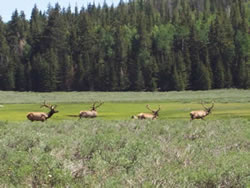Fishlake National Forest
| USDA for Kids | |
| National Recreation Information Center | |
| Recreation.gov - Your reservation center for passes, camping and other recreational activities | |
| Evaluate Our
Service We welcome your comments on our service and your suggestions for improvement. |
Fishlake National Forest (435) 896-9233 |
|
|
|
Fishlake National Forest > Recreational Activities > Recreation Facility Analysis
Recreation Facility Analysis
Forest Priorities | Glossary | Monitoring | Site Specific Actions
Fishlake National Forest
Recreation Niche
April 2006
![]()
 Blazing the Trail
Blazing the Trail
Named after the largest lake on the forest, the Fishlake National Forest offers open, accessible landscapes that invite visitors in. A well managed system of routes traverse long distances and link with on another, to create a web of corridors that engage local populations. the nationally known Paiute Trail system is an extension of the local communities. The scenic landscapes of the Fishlake National Forest reveal secrets and stories of past settlements and civilizations while providing a modern day backyard for today's towns and communities. Routes and trails on the Forest are a means to access dispersed opportunities such as hunting, fishing and viewing. Dispersed camping is often family oriented and transforms Forest settings into mini-communities during peak seasons of use.
 Settings, Special Places, and Values
Settings, Special Places, and Values
The Forest encompasses approximately 1.5 million acres of mountains, plateaus, and red canyons. The topography of the Forest is spectacular and includes such landmarks as Fish Lake Basin, Tushare Mountains, and Boulder Mountain. The forest has a rich history of settlement and use by past generations, evidenced by remnants of mining towns, homesteads, cabins. Prehistoric residents have also left lingering imprints such as pictographs and petroglyphs. unique to the Fishlake National Forest are the vast expanses of backcountry. In addition to unsurpassed motorized opportunities, the settings engage visitors seeking adventure, challenge, rish and exploration. Scenic Byways provide linkages to surrounding National Parks and provide access to lake destinations on the Forest. At an early age, users develop a respect and appreciation for the natural settings that they visit.
Trails/Town Ties
These areas provide a unique, interconnected travel system linking spectacular scenic vistas to local communities. They include the neighborhood links, as well as the primary OHV corridors - Paiute and Great Western Trail Systems.
Seated Scenic
These areas are the more remote areas accessed from the primary travel ways and used by locals engaging in a wide range of dispersed activities. These areas are valued for their remote character and opportunity for solitude and challenge.
Quiet
Settings are remote and seen by few. Topography is often steep and rugged. These areas are roadless and primitive.
Infrastructure
These areas are along the scenic byways and backways of the Forest and surrounding destination lakes. Concentrated use occurs in developed facilities, offering a more structured visit. Fish Lake Basin and historic Fish Lake Lodge have a long tradition of this type of use.
 Activities/Opportunities
Activities/Opportunities
The Forest focus is OHV use and dispersed recreation for hunting, fishing, wildlife viewing, and camping. Dispersed Camping, particularly in large family groups, is popular during the summer and fall hunts. Other public lands (State and National Parks) compliment these dispersed opportunities by providing more structured settings and services. Partners are also critical in carrying out the well managed recreation programs on the Forest.
Trails/Town Ties
Local communities provide lodging, fuel, food and supplies to those using the adjacent National Forest. A challenging and scenic riding adventure is provided by the nationally recognized Paiute loop trail as well as the Great Western loop trail. Additional connector trails create a model OHV trail sytem of over 1,000 miles. concentrated dispersed camping areas serve as staging areas and support the trail system. Interpretation and education opportunities are provided at key locations.
Seated Scenic
 Recreationists travel via motorized and non-motorized ways to partake in dispersed activities such as fishing, hunting, and wildlife viewing. There is a sense of "getting away" for discovery of adventure.
Recreationists travel via motorized and non-motorized ways to partake in dispersed activities such as fishing, hunting, and wildlife viewing. There is a sense of "getting away" for discovery of adventure.
Quiet
This non-motorized backcountry setting is used by equestrians and hikers. Viewing scenery and wildlife are important components.
Infrastructure
Scenic byways and backways provide a driving oppportunity to view scenery and wildlife, learn about the Forest history, and camp in developed areas. Interpretation and education opportunities are provided at key locations. Developed camping, lodging, and fishing are concentrated at Fish Lake.
Primary Visitors
Local: 15 minutes |
Surrounding counties: 2 hours |
Beyond surrounding counties |
backyard cultural connection community trail ties motorized modern pioneer |
latest motorized equipment family oriented dispersed user |
family or past connection diverse activities motorized trail user |
USDA Forest Service - Fishlake National Forest
Last Modified: Tuesday, 15 April 2008 at 23:32:24 EDT